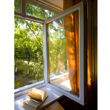

The NHBC Foundation has launched a new guide to help housebuilders and designers deal with the growing problem of overheating in newbuild homes.
The Guide 'Understanding overheating – where to start' examines how higher standards of airtightness and increased thermal insulation are making overheating a growing problem in newbuild houses.
Historically, overheating in homes has not been a major problem in the UK, at least partly due to the heavyweight building materials used in more traditional home construction, and the low levels of thermal insulation these materials have. According to the NHBC Foundation this, along with gaps in building fabric such as chimneys and sash windows, have made older homes less energy-efficient, but have provided ventilation that helps keep them cool during the summer.
Newbuild homes, in contrast, are usually double-glazed and far more airtight to improve their energy efficiency.
Overheating is generally understood to be the accumulation of warmth within a building to an extent where it causes discomfort to the occupants. There is no clear definition of the term ‘overheating’, or the specific conditions under which this can be said to occur. Nor is there any statutory maximum internal temperature in UK Building Regulations or current health and safety guidance.
However, research carried out by CIBSE and Arup suggest that most people begin to feel warm at 25ºC and hot at 28ºC. Their report also defines 35ºC as the internal temperature above which there is a significant danger of heat stress. Other factors such as lack of air movement and sustained periods of high temperatures also affect people’s comfort levels.
The health impacts of overheating can include an increased risk of illness from respiratory and cardiovascular disease, and the consequences of extreme temperatures sustained over a period are significant – the summer heat wave in 2003 resulted in more than 2,000 extra deaths in the UK. There are also instances in urban areas where serious health issues caused by overheating have led to legal action being taken against landlords.
Neil Smith, group research and innovation manager at NHBC, said: “As new homes become more energy-efficient and constructed to achieve higher levels of airtightness, the issue of overheating becomes ever more crucial. Not only is overheating a potential risk to health, but the discomfort of living in an overheated house could lead to occupants offsetting the energy efficiency of their home by using fixed or portable air conditioning units.
“The publication of Understanding Overheating will provide timely guidance to housebuilders and designers, explaining simply and clearly the key aspects of design and specification they should consider to avoid future problems in their newbuilds.”
Further research on overheating by NHBC Foundation will be published later in the year.
To download the full report, visit www.nhbcfoundation.org.
If you'd like to keep up-to-date with the latest developments in the heating and plumbing industry, why not subscribe to our weekly newsletters? Just click the button below and you can ensure all the latest industry news and new product information lands in your inbox every week.